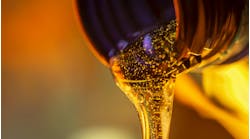What to know about EV driveline lubricants
Fleet maintenance managers and technicians have a lot to prepare for as commercial electric vehicles become more common, from how to service high-voltage components to what parts to keep in stock. Even with the elimination of engines—and engine oil, the driveline will still have moving parts, and therefore you'll need to keep some lubricants on the shelf. Here's a primer on what to know about these new EV lubricants.
Efficiency and protection
Efficiency in a driveline unit is vital when it comes to EVs, meaning there are a number of key factors to consider when selecting a lubricant.
A unique challenge to EVs is that heat must be removed from the motor as quickly as possible to improve its performance and overall system efficiency. This means that EV lubricants must have exceptional heat transfer characteristics, with lower viscosity fluids playing a major role in fluid thermal management. As a result, EV lubricants have typically lower viscosities than conventional automatic transmission lubricants, becoming an essential consideration for EV fluid formulators when developing lubricants to meet the requirements of these electric drive units.
Additionally, electric motors run at high revolutions per minute (RPMs), meaning the driveline lubricants need to work hard to protect gears from wear damage. Heavy-duty vehicles subjected to intensive road time and heavy loads rely even more on proper gear lubrication to avoid unplanned maintenance and costly downtime. Success means the lubricants will reliably transfer power to the wheelbase with minimum drag and churning in the gear set, all the while providing the protection that is required to keep the vehicle working for longer.
Because driveline lubricants for EVs are typically low-viscosity fluids, they provide better flow throughout the electric motor and parts. The appropriate fluid can help reduce friction on the gears and bearings while allowing improved heat transfer and thermal efficiency. Combined, the motor will be able to run at its highest efficiency, keeping copper windings and motor components within optimal electrical motor efficiency.
Read more: Petro-Canada Lubricants launches EV fluid product line
Material compatability and conductivity
Due to the copper hairpin windings and electronic components present in electric engines, material compatibility is an essential consideration with EV components. When selecting a lubricant, fleet managers must factor in the electrical properties of EV fluids to make sure they are compatible with the electric drive unit components to avoid any damage.
While an ICE-based driveline fluid, used by most heavy-duty fleets today, is primarily focused on durability and performance, for EV lubricants, a key feature is to include a balanced electrical conductivity, while avoiding issues with electrical arcing or sudden electrical discharge.
The hardware of an EV is fundamentally different to an ICE, and in many cases the motor is in the same compartment as the gearbox. As there is an electrical current going through more components, original equipment manufacturers (OEMs) must work collaboratively with EV fluid developers to design lubricants to their optimum conductivity.
While a focus on conductivity and compatibility is key, maintaining adequate wear protection will remain pivotal. This is particularly true for heavy-duty vehicles subjected to high loads for long periods of time. A quality EV fluid will protect the e-driveline unit by providing adequate protection, electrical properties, and compatibility with copper and new materials while improving the unit's efficiency.
Thermal management and cooling
Thermal management lubricants are vital to EVs and require a careful balance between thermal insulating quality and electrical non-conductivity to prevent the build-up of electrostatic charges.
There are two types of fluid technologies for cooling in EVs – direct and indirect. Most major manufacturers have, to date, used indirect cooling, meaning various surfaces and plates are cooled by a cooling fluid, which then cools battery cells. This method does have some safety concerns, primarily, if there is a fire in one cell, it can spread to other cells and cause an explosion.
Comparably, direct cooling, or immersion cooling, while not directly used yet in many EVs, involves dielectric lubricants which help dissipate the heat from the battery and can reduce the chance of thermal runaway or explosion.
Requirements for EV bearing grease
The high operating speeds and material compatibility requirements of the electric motors in heavy-duty EVs require specialized greases. These greases provide extended high-speed bearing life through enhanced oxidative and thermal stability. They also use carefully selected base lubricants, thickeners, and additive systems to provide both low friction to extend driving range and low noise operation. In addition, the additive systems must avoid the use of corrosive extreme pressure (EP) additives, which can damage the copper motor windings. A final consideration is electrical conductivity. EV greases need optimized conductivity to protect bearings from damage due to electrical discharge.
The unique aspects of EVs impact grease choices in other areas as well. EVs are typically significantly heavier than their ICE counterparts due to their batteries. This added weight means extra stress on driveline components such as the constant-velocity (CV) joints. As such, fleets must consider more specialized CV joint greases that have higher EP protection than in a traditional vehicle.
While EVs may not be commonplace in heavy-duty fleets just yet, the journey towards electrification is well underway, making it important that fleet managers keep abreast of key considerations arising from its introduction, such as those outlined above, as well as the technological advancements taking place to get us there.
Darryl Purificati is senior Technical Advisor, OEM/Automotive at HF Sinclair, which includes Petro-Canada Lubricants. He has 27 years of experience working in the oil and energy sector as a technical advisor, and is also widely involved within the industry as an active member of the American Petroleum Institute (API), ASTM International, and the Society of Automobile Engineers (SAE).




